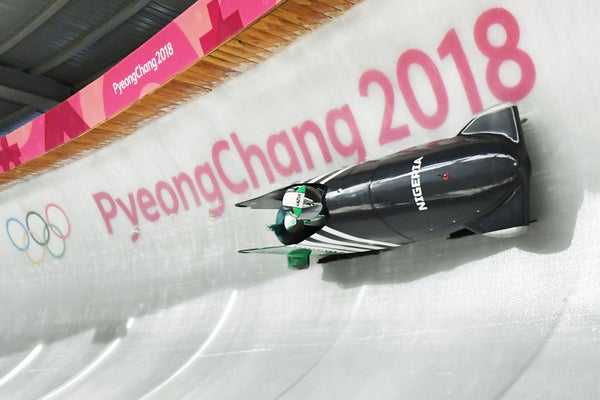Nigeria becomes the first-ever African team to compete in the Bobsled and Skeleton events in the next few days at the PyeongChang Winter Olympics. That team joins Jamaica’s women bobsledders—also making their Winter Olympics debut (exactly 30 years after the Jamaican men’s team of Cool Runnings fame competed at the 1998 Winter Games)—and a handful of other competitors who hail from places where it rarely, if ever, gets cold enough to snow.
Not surprisingly, the favorites to medal in those events—including Canada, Germany and the U.S.—all benefit from frosty winter months conducive to cultivating ice-sport athletes from a young age. Further evidence of the Winter Games’ inherent bias toward athletes native to cold climes: Team Nigeria bobsled driver Seun Adigun actually grew up just outside of Chicago and Akuoma Omeoga (one of the two brakewomen) is from Minnesota.
Scientists and sports enthusiasts alike have long been looking to level this frigid playing field via the development of plastics that can serve as synthetic ice to line backyard hockey and ice-skating rinks. But the type of polymer needed to coat a sloping two-kilometer track—one that can accommodate sleds traveling in excess of 125 kilometers per hour—has proved much more elusive. “Any synthetic track needs to offer a similar sliding and driving experience to ice and not create any concerns about athlete safety,” says Jan-Anders Månsson, director of Purdue University’s Composites Manufacturing and Simulation Center and a professor in materials and chemical engineering. “It also needs to be both durable and cost-effective.”
On supporting science journalism
If you're enjoying this article, consider supporting our award-winning journalism by subscribing. By purchasing a subscription you are helping to ensure the future of impactful stories about the discoveries and ideas shaping our world today.
Månsson has spent the past several years investigating how a type of high-density plastic called “ultrahigh-molecular-weight” polyethylene could be used to replace ice as the track lining for Olympic sled sports, including bobsled, luge and skeleton. Such plastics are currently used as protective coatings for a variety of objects—including artificial joints and other biomedical devices as well as dump truck beds—to protect them from abrasions. The material is a variation on the polyethylene used to make shopping bags, and gets its strength from its structure of extremely long, overlapping chains of molecules. These chains all align in the same direction, enabling the material to better transfer heavy loads placed on it, says Susan Selke, director of Michigan State University’s School of Packaging. “In general, the higher the molecular weight—or mass—the stronger and more scratch-resistant the plastic is,” Selke says. One of the challenges to working with such a material is its high viscosity, or resistance to flow, which means it must be processed at higher temperatures in order to be made to take a particular shape, she adds.
A synthetic track misted with water could in theory almost mimic the friction level that the stainless-steel runners of bobsleds, luge sleds and skeleton sleds encounter on actual ice, according to Månsson (who is a former president of the International Academy of Sports Science and Technology, an International Olympic Committee). Such a pathway would also have nearly the same speed profile as an ice track, allowing the sleds to reach more than 100 kilometers per hour within the first 600 meters, Månsson says. “A good ice driver would be good on this surface, too,” he adds. “We don’t want to create a new sport and new athletes.”
The main problem with long, ice-lined tracks is they are expensive to build and maintain—a major reason why only 16 of them exist worldwide. The reinforced concrete bobsled track built for the 2006 Turin Olympics, for example, cost about $100 million to build and another $1 million annually to maintain due to the refrigeration system required to cool its surface. Bobsled has been part of the Olympics since the first Winter Games in 1924. (The only exception was the 1960 games in Squaw Valley, Calif., when the organizing committee decided not to build a track in order to cut costs.) Such tracks host very few competitions each year and, in some cases, are not used at all following the Olympics.
A plastic track would cost about $5 million to build and could be cost-effectively maintained for year-round use—even in warmer locations—Månsson says. Such accessibility is crucial to cultivating future generations of winter sled-sport athletes, particularly as those more traditional sports compete with snowboarding and other X Games events for young athletes’ attention, he says.
As much as plastic tracks might help attract attention to sled sports in more tropical locales, the path to building a prototype has been anything but smooth. Månsson completed a feasibility study in 2015. But his efforts to secure the roughly $300,000 in funding needed to build a 200-meter test track at the École Polytechnique Fédérale de Lausanne in Switzerland, where he began his research, were interrupted by his move to Purdue in September 2016. Månsson’s study aside, there are a lot of questions about how to actually build such a track. It would most likely have to be constructed using two- to three-meter lengths of plastic joined by a flexible material, which could accommodate the plastic pieces’ shrinkage in the cold and expansion in the heat. Månsson had originally targeted the 2020 Youth Olympic Games in Lausanne as the inaugural venue for a full-length plastic track, but those plans were shelved without a sample track to show officials.
Until those kinks are worked out and the power of plastic is proved, it is likely countries currently dominating sled sports will continue to do so.
